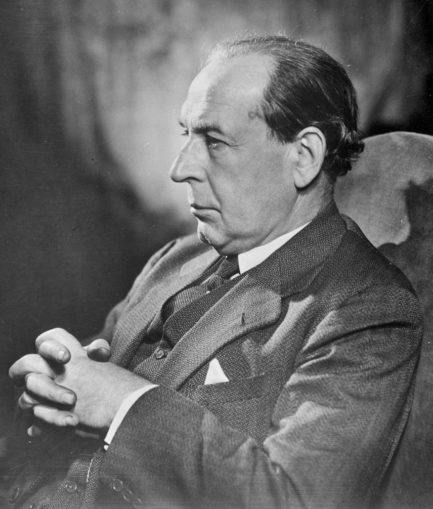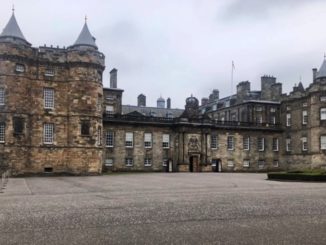
Yousuf Karsh, CC BY-SA 3.0 NL, via Wikimedia Commons
On one of AWS’s recent informative pieces on Scotland, he mentioned Waverley Station in Edinburgh and I mentioned in the comments (which nobody reads) that perhaps the most versatile civil servant ever, John Anderson, took the name of the station for the title of his peerage. Sharpie kindly suggested that I wrote about his extraordinary career.
John Anderson was born in Edinburgh in 1882 of a middle class family and after attending Watson’s school, won a scholarship to Edinburgh University where he graduated with first class honours in mathematics and natural philosophy (or physics as it is called outside of Scottish universities) and thereafter studied chemistry at Leipzig University in Germany. However at the age of 23 he abandoned science to be able to afford to marry his childhood sweetheart, Chrissie McKenzie, and joined the Civil Service after recording a score in his entrance exams which was at the time the second highest ever known. He rose swiftly through the ranks initially as a UK based official in the Colonial Office, then the Home Civil service to introduce Lloyd George’s National Insurance and the First World War brought his scientific background to the fore in devising alternative sources of supplies of pharmaceuticals previously imported from Germany and then dealing with the shipping priorities. He was knighted in 1919 at age of 37 having already become Chairman of the Board of Inland Revenue.
Calamity struck. Chrissie died leaving him a widower with two small children. Perhaps it was his single status that encouraged David Lloyd George to send him to Dublin Castle to galvanise the broken down administration during the worst of the “War of independence”. British policy worked (or failed to work) on several levels. The “Tan War” reverberates in the Irish Republic to this day. It is less well known that Anderson’s deputy , “Andy” (later Sir Alfred) Cope was in day to day contact with Michael Collins and other IRA leaders throughout with Lloyd George’s approval to broker a settlement notwithstanding a full scale insurgency and an official Government price on their heads. Thirty years later Cope declined to assist an official Irish record of the time on the grounds that his story would spoil the official legend of their apparent military triumph.
Anderson returned to London and the new Prime Minister Stanley Baldwin requested him to chair a secret committee to deal with the consequences of a General Strike which was already foreseen. Two years later it happened. It lasted a week. Anderson had prepared for the country surviving one lasting nine months.
He had reached the top of the civil service far too early and by a chapter of accidents was sent out to Calcutta to be Governor of Bengal in succession to F S Jackson, the former Yorkshire and England cricket captain, in 1931. He made a point of visiting all the provinces within his responsibility and recommended changes for the forthcoming Government of India Act of 1935 which was intended to send India on the path to Dominion status similar to Australia, New Zealand, Canada and South Africa and the Treaty Irish Free State he had had a hand in establishing. Whilst there he survived two serious assassination attempts, the one at Calcutta racecourse notoriously so, which, together with a failed attempt in Dublin , gave him a reputation for luck and the singularly inappropriate nickname of “Tiger” Anderson. He later commuted the death sentences passed on three of his five attempted Indian assassins. He let justice take its course on the remaining two.
Anderson returned home in 1938 and entered politics in a peculiarly civil service manner. He was elected MP for the Scottish Universities standing as a non party political candidate who nevertheless supported the then National Government. In short order he entered cabinet as Lord Privy Seal and was tasked with the provision of air raid shelters for the public. In consequence he is remembered for the prefabricated corrugated iron, partially buried, garden shelters known as Anderson shelters which, as a boy, I still recall in back gardens in the 1960s.
On the commencement of hostilities, Anderson was made Home Secretary and given the task of rounding up potential enemy aliens.. Law students to this day study the case of Liversedge vs Anderson on the limits of the executive power of the state to detain without trial in time of war. This office was a rare failure. He was replaced by Herbert Morrison, grandfather of Peter Mandelson, who was thought to be more politically aware and sympathetic on the floor of the House of Commons. Instead he was made Lord President and asked to chair the Tube Alloys committee in view of his youthful scientific training. It was the code name for the UK’s nuclear weapons programme and he continued to chair it even after Labour took power in 1945, such was Attlee’s confidence in him until the disgraceful betrayal of the McMahon Act of 1946 whereby the US effectively appropriated all the nuclear “know how” we had provided to them for the bomb project without return. Ironically the British were far in advance of Heisenberg’s German team anyway before any US involvement.
In 1943, the Chancellor of the Exchequer, Sir Kingsley Wood, died suddenly and Anderson, with his experience of being Chairman of the Board of Inland Revenue was the obvious candidate to replace him quickly. Wood had prepared new schemes for the collection of taxes which remain to this day such as PAYE and it fell to Anderson to implement them. Such was Anderson’s power and reputation that when Churchill and Eden left to attend the Tehran conference in 1944, Churchill left a memorandum to the King advising that Anderson be appointed Prime Minister if neither returned.
Although Anderson was offered a peerage at the end of the War he remained in the House of Commons until 1950 when his political career ended in the peculiar way it had started. The Attlee Government had abolished the “University” seats, to leave the present day system of geographical constituencies only. Although the Tories offered to find him a safe seat, he declined and went to the House of Lords as Viscount Waverley leading the public to think he had named his title after the railway station in his home city of Edinburgh.
He remarried in old age and was given the task of chairing the reconstruction of London Docks following the Blitz as Chairman of the Port of London Authority. The docks were successfully rebuilt but London lasted as a port for little more than a quarter of a century. Containerisation and labour problems killed it and it is now the futuresque landscape of Canary Wharf. He became Chairman of the Royal Opera as a reward for drawing up the wartime plans that led to the establishment of the Arts Council. He was unusually as a non practising scientist made a Fellow of the Royal Society for the support he had given British science during the war years. Now largely forgotten, his name is sometimes recalled when the “Waverley criteria” are consulted. These are conditions that he drew up that govern the export of great works of art from these shores and when the Government can prevent their export, to the chagrin of their owners, and remain in force to this day.
Having received nearly every honour that a grateful nation could award, the late Queen decided to award him the Order of Merit. However he was already gravely ill so that the announcement was made in advance of the usual honours list, much in the way that the novelist Martin Amis received his knighthood before his recent death. Anderson had the award bestowed upon him in hospital death bed in 1958. He observed that he thought that the civil service would be pleased.
© Bergen 2024



